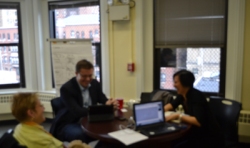Tuesday, November 27th, 2012 was the first #GivingTuesday™—started as a day to celebrate giving—following the consumer spending activities of Black Friday and Cyber Monday. We are now at the six-month mark before the next one on Tuesday, December 3, 2013.
Henry Timms is the creator of the #GivingTuesday movement and is the Deputy Executive Director of the 92nd Street Y as well as co-producer of the Social Good Summit. We were introduced to Henry by Eileen Heisman, President/CEO of National Philanthropic Trust, during his visit to lecture for her class at Penn’s School of Social Policy & Practice.
We asked him about the purpose of #GivingTuesday, lessons learned from last year’s activities, and what to look forward to this year and beyond. This the first part of our Q&A with Henry, with more to follow leading up to this year’s giving season.

(left) Eileen Heisman, (middle) Henry Timms, (right) Kat Rosqueta
Read more…
AW: What do you see as the ultimate goal of #GivingTuesday?
HT: That will be for the community to decide for themselves. Our goal was to be a part of a community that would grow in the same way that Black Friday and Cyber Monday are known in the national consciousness. #GivingTuesday had a good impact in Year One but there’s a long way to go.
From a social media perspective, we did about half the traffic of Cyber Monday, and about a third of the traffic of Black Friday. That was quite interesting—that we became a credible bronze medal—but we have a long way to go.
I was at a class at Wharton, and I was asking that class about who had heard of #GivingTuesday—out of 30 of them, maybe 4 hands went up. So it wasn’t as if this has scaled to such a degree that everybody knows about it. We have a lot of building to do.
AW: Are you planning to measure the impact of #GivingTuesday, and if so, how are you planning to do that?
HT: We’ve seen some really interesting measurements coming back. Our initial goal from a partnership perspective had been to get over 100 partners from across the country. We saw 2,500 in total at the end of the campaign, which was amazing—a first metric from our perspective. We also were thinking a lot about national reach, so all 50 states participating was a really important thing for us.
What was also fun was when we needed 3 states to get to 50, a lot of people in the #GivingTuesday community started pushing and encouraging people in those states—a very interesting community approach.
We thought a lot about the data we’ve received from our partners. Obviously, measurement was critical to this, so one of the things we asked from our partners was, “how effective was your #GivingTuesday campaign?” We got a lot of data back, and actually some very encouraging measurements from our partners in terms of what they saw throughout the day and throughout the season. We also saw some very good year-on-year numbers around how much online giving increased.
A number of different platforms measured around a 50% increase against the same day of the year before, which was a good number for Year One and does give us a nice benchmark for this point. One of the things that #GivingTuesday was helpful in was helping organizations tell stories, which encouraged new people to get engaged with some of their work. I think we’ll see some more of that in the future.
AW: There’s a recurring gift if they come back—like on a website, you have new vs. returning visitors—it’s a good way to start tracking.
HT: I think that’s right, and that actually leads to another point from the surveys we’ve done. We expect around 95% of the people who took part last year to commit to take part again. That was an interesting sign of the levels of enthusiasm, and was a healthy number. That felt like an endorsement.
AW: In regards to the audience, if you do a search on Twitter for #GivingTuesday, you can see people having conversations. Obviously, the main audience for this movement is people working in the nonprofit sector who are already operating in the space. Do you have any kind of data on “everyday” people who got involved, or maybe people who are the beneficiaries of the nonprofits that are raising money?
HT: I think that’s the right question, and it’s one of the things that we’ve heard. #GivingTuesday has events all around the country where we’ll meet with the sector leaders and really just ask two questions:
- What ideas do you have to take this movement to scale?
- What do you think your organization could be thinking about in terms of your #GivingTuesday participation?
That has led to so many interesting ideas. One of those ideas is around #GivingTuesday being the day in which people would make commitment to yearlong activities, which is to say, “On #GivingTuesday, I commit to a monthly contribution to Save the Children;” or “On #GivingTuesday, you launched your first payroll giving scheme;” or “On #GivingTuesday you made a pledge to increase your giving for the year by 15%…” whatever it may be. There are different organizations working on that idea now—it’s a big idea, and if we see people pledging longer-term activity, that would be a very powerful thing.
Stay tuned…
Part 2, coming next month with a discussion about the Giving Pledge, celebrity involvement, and more!
